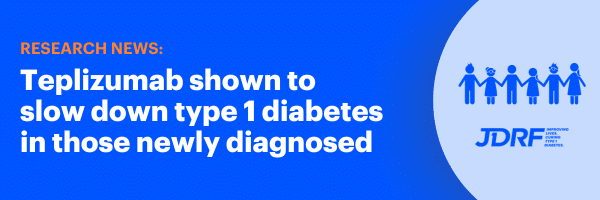Teplizumab shown to slow down type 1 diabetes in those newly diagnosed

Research findings have just been released for the PROTECT clinical trial which tested whether the disease-modifying therapy Teplizumab is able to delay type 1 diabetes (T1D) progression in those newly diagnosed.
What is Teplizumab?
Teplizumab is a therapy which has been shown to delay the progression from an early stage of T1D (Stage 2) to clinical diagnosis (Stage 3) in those at risk. It was approved for this purpose by the US FDA in November 2022 and was the first therapy since the discovery of insulin for treating T1D. Until now, it was unknown whether Teplizumab could also be used at a later stage – after diagnosis (Stage 3) – to slow down T1D progression and maintain insulin production.
T1D occurs when the immune system mistakenly attacks the insulin-producing beta cells in the pancreas, destroying them until the body can no longer produce its own insulin. Teplizumab is works by intercepting the immune system attack of beta cells, allowing them to survive and continue to produce insulin.
What was the PROTECT study about and what did it show?
The study sought to test whether Teplizumab could be used to delay progression of T1D soon after diagnosis. Often in people newly diagnosed with T1D there remains some level of beta cell function and thus insulin production. This is called the ‘honeymoon period’ or ‘honeymoon phase’ and is a period associated with little insulin use. Using drugs to protect the remaining beta cells from further immune system attack may help people to produce insulin for longer, with better health outcomes.
The PROTECT clinical trial tested Teplizumab on 217 children and teenagers (8 to 17 years) who were diagnosed with T1D in the preceding 6 weeks. They were administered Teplizumab and followed up for 1.5 years (78 weeks). The main outcome investigated was whether Teplizumab could maintain beta cell function when compared to a control group who were given a placebo. Beta cell function was analysed by the production of C-peptide which is a marker of insulin production.
The trial also investigated the amount of insulin used by participants, the amount of time they spent in the safe blood glucose range (time in range), long term blood glucose control (HbA1c) and safety of the Teplizumab.
The PROTECT study showed that participants given Teplizumab had a slower loss in beta cell function after diagnosis compared to the placebo group. This suggests that using Teplizumab may preserve some level of beta cells following T1D diagnosis. The Teplizumab group did not achieve significant improvement in the amount of insulin needed or time in range compared to the placebo group in this study.
Why is this important?
The PROTECT study raises the possibility that we may be able to use Teplizumab not only in the early, pre-symptomatic stages of T1D in those at risk, but also following diagnosis to slow down the progression of the condition. This would allow some beta cells to remain alive and active, and in turn, reduce the need for insulin.
“The results from the PROTECT study are encouraging and add to a number of new therapeutic options called disease-modifying therapies that are currently being tested to change the course of T1D. Eventually our vision is to significantly delay insulin initiation or even prevent those at risk from developing T1D altogether.”
Dr Dorota Pawlak, Chief Scientific Officer, JDRF Australia
How was JDRF involved?
JDRF around the world has been instrumental to funding the early research in the development of Teplizumab including research in pre-clinical models, trial recruitment, and funding the clinical trials themselves.
Explore our research
JDRF is committed to finding a cure for T1D. We are pursuing different avenues to meet this goal, including investing in research into disease-modifying therapies. To see all research projects funded in Australia, including work on disease-modifying therapies please see our research pages.




